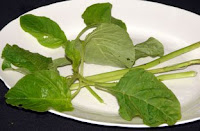Available all year, peak March to June.
Whether growers pick flat-leaf varieties or those with crinkly textures like other cooking greens, harvesting spinach is intimate business.
Extracting tender leaves requires getting down on hands and knees and hand-plucking them from the plant. But despite the delicate treatment it requires, spinach can also have tough grit and should be dunked in cold water and drained at least once to remove sand or dirt. All that washing is worth your while - at only 7 calories percup, this veggie is an excellent source of fiber, folate and vitamin C, and provides a whopping 20 percent of the recommended daily allowance of vitamin A.
Spinach was first cultivated in ancient Persia, now Iran, where it's still a favorite ingredient in soup, stews, and flaky turnovers. it quickly became a staple in cultures and cuisines around the world. Indians use it in pesto-like purees with raw garlic, and Chinese saute it. The French incorporate it into savory tarts, Italians like it on pizza and who here in Popeye-land can resist spinach when it's steamed with a squeeze of lemon or a dash of hot sauce ??
Look for dark green, fresh leaves. Avoid yellow, wilted, bruised or mushy leaves. Refrigerate, unwashed, in a plastic bag up to 3 days.
COOKING TIME :
- Steam : 5 to 6 minutes
- Microwave : 3 to 4 minutes
- Blanch : 2 to 3 minutes
- Boil : 2 to 5 minutes
- Other : stir-fry for 3 minutes
TIPS :
Spinach should only ever be cooked once and never re-heat-ed, since otherwise it can release harmful nitrite.









No comments:
Post a Comment